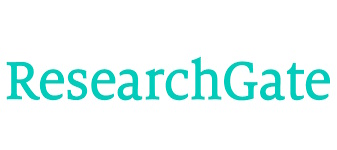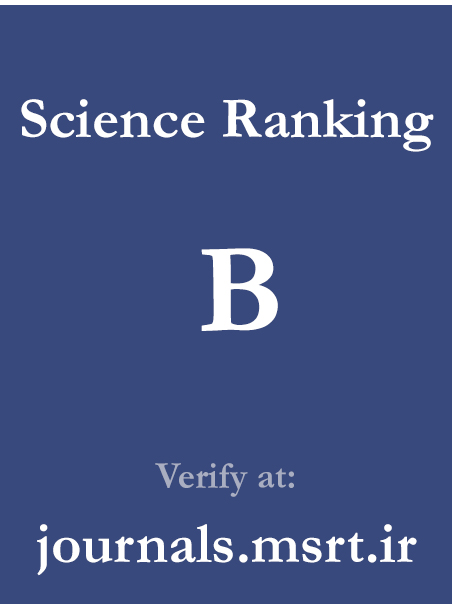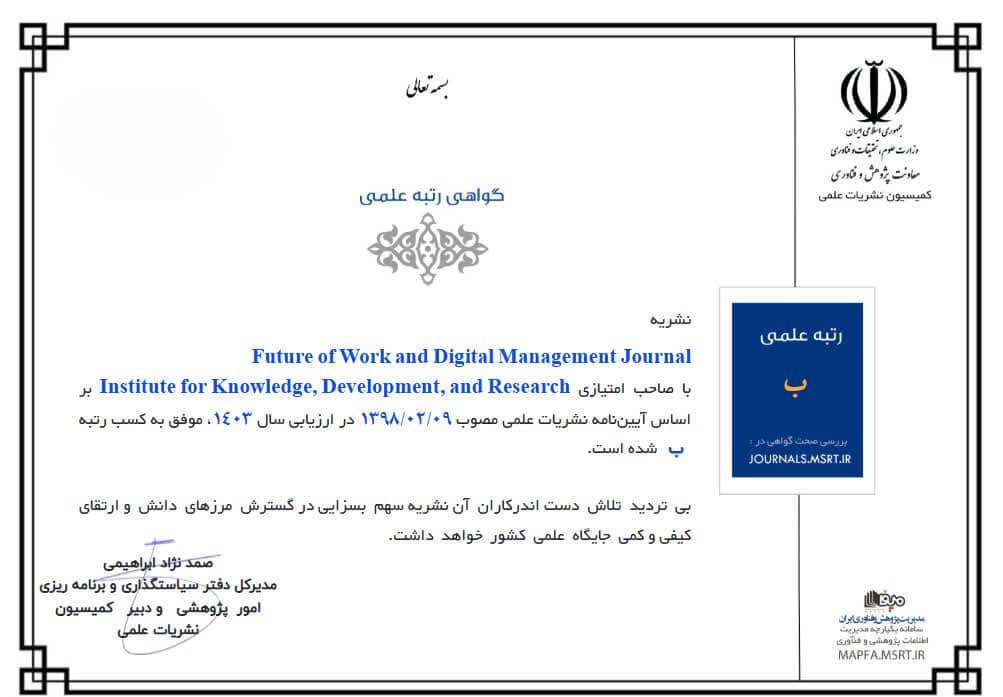Proposing a Conceptual Model of the Drivers and Inhibitors of Conspiracy Beliefs in Iranian Public Organizations
Keywords:
conspiracy belief, public organizations, political behavior, thematic analysis, conceptual modelAbstract
Conspiracy belief in public organizations refers to the perception that others are secretly and malevolently acting against one’s interests. This phenomenon can lead to reduced collaboration, organizational isolation, lack of transparency, and inefficiency in responding to societal needs. The purpose of this study was to propose a conceptual model of the drivers and inhibitors of conspiracy belief in Iranian public organizations. A qualitative research design based on thematic analysis was employed. Data were collected through 15 in-depth semi-structured interviews with experts in management, human resources, social sciences, sociology, and psychology. Data analysis followed Braun and Clarke’s six-phase approach and resulted in 157 initial codes, 18 components, and six main dimensions. To ensure validity, member checking and meticulous documentation of the research process were conducted. Reliability was assessed using the inter-coder agreement method, yielding 82.4%. Findings revealed that individual psychological factors (need for control, anxiety level, confirmation bias), socio-cultural factors (cultural norms, group belonging, social polarization), political-institutional factors (centralization of power, perceived corruption), informational-media factors (organizational rumors, information restrictions), economic factors (resource scarcity, economic inequality), and organizational-managerial factors (authoritarian leadership, work pressure) act as key drivers of conspiracy belief. Conversely, inhibitors such as tolerance of ambiguity, social trust, organizational transparency, critical thinking, job security, and participative leadership can reduce this phenomenon. The proposed model provides a comprehensive framework for managing conspiracy beliefs and improving the performance of public organizations.
Downloads
References
[1] C. Baden and T. Sharon, "Blinded by the lies? Toward an integrated definition of conspiracy theories," Communication Theory, vol. 31, no. 1, pp. 82-106, 2021, doi: 10.1093/ct/qtaa023.
[2] K. M. Douglas, R. M. Sutton, and A. Cichocka, "Belief in conspiracy theories: Looking beyond gullibility," in The social psychology of gullibility: Routledge, 2019, pp. 61-76.
[3] L. Tam, H. Lee, and J. N. Kim, "Conspiratorial thinking in the workplace: how it happens and why it matters," Journal of Communication Management, 2024, doi: 10.1108/JCOM-12-2023-0139.
[4] K. M. Douglas and A. C. Leite, "Suspicion in the workplace: Organizational conspiracy theories and work‐related outcomes," British Journal of Psychology, vol. 108, no. 3, pp. 486-506, 2017, doi: 10.1111/bjop.12212.
[5] H. Mintzberg, Power In and Around Organizations. Prentice-Hall, 1983.
[6] J. Pfeffer, Managing with power: Politics and influence in organizations. Harvard Business Press, 1993.
[7] A. A. Johnson, "Conspiracy thinking," in Handbook on Democracy and Security: Edward Elgar Publishing, 2023, pp. 289-308.
[8] J. E. Oliver and T. J. Wood, "Conspiracy theories and the paranoid style (s) of mass opinion," American journal of political science, vol. 58, no. 4, pp. 952-966, 2014, doi: 10.1111/ajps.12084.
[9] K. M. Douglas, A. Cichocka, and R. M. Sutton, "Motivations, emotions and belief in conspiracy theories," in Routledge handbook of conspiracy theories: Routledge, 2020, pp. 181-191.
[10] D. Jolley, R. Meleady, and K. M. Douglas, "Exposure to intergroup conspiracy theories promotes prejudice which spreads across groups," British Journal of Psychology, vol. 111, no. 1, pp. 17-35, 2020, doi: 10.1111/bjop.12385.
[11] V. Swami, T. Chamorro‐Premuzic, and A. Furnham, "Unanswered questions: A preliminary investigation of personality and individual difference predictors of 9/11 conspiracist beliefs," Applied cognitive psychology, vol. 24, no. 6, pp. 749-761, 2010, doi: 10.1002/acp.1583.
[12] S. Wich, "Delusion Is No Illusion," Management Report for Nonunion Organizations, vol. 45, no. 10, pp. 3-4, 2022.
[13] J. W. Van Prooijen and M. Song, "The cultural dimension of intergroup conspiracy theories," British Journal of Psychology, vol. 112, no. 2, pp. 455-473, 2021, doi: 10.1111/bjop.12471.
[14] A. Cichocka, M. Marchlewska, A. Golec de Zavala, and M. Olechowski, "'They will not control us': Ingroup positivity and belief in intergroup conspiracies," British journal of psychology, vol. 107, no. 3, pp. 556-576, 2016, doi: 10.1111/bjop.12158.
[15] M. H. Taheri and M. Ataei, "Designing a Model of Political Behavior in Iranian Governmental Organizations," Scientific Journal of New Research Approaches in Management and Accounting, vol. 5, no. 19, pp. 1142-1162, 2021.
[16] M. Sanaei, H. Ja'farian, and M. Samanian, "Political Behavior of Governmental Managers and Its Causes in the Organization," Iranian Political Sociology Monthly, vol. 5, no. 11, pp. 2894-2911, 2022.
[17] H. Damghanian, A. Saberi, and B. Fakhraei, "Identifying and Explaining Political Behaviors of Education Employees: A Mixed-Methods Study," Scientific Journal of Organizational Culture Management, 2024.
[18] J. A. Whitson and A. D. Galinsky, "Lacking control increases illusory pattern perception," science, vol. 322, no. 5898, pp. 115-117, 2008, doi: 10.1126/science.1159845.
[19] H. Kelley, "Attribution theory and research," Annual Review of Psychology, vol. 31, pp. 1-32, 1980, doi: 10.1146/annurev.ps.31.020180.002325.
[20] S. Sajadi, D. Kiakojouri, and G. Hatami, "The Relationship Between Anxiety and Difficulties in Emotion Regulation with General Health and Psychological Hardiness in Students of Islamic Azad University," Indian Journal of Fundamental and Applied Life Sciences, vol. 2, no. 3, pp. 117-125, 2012.
[21] K. M. Douglas and R. M. Sutton, "Does it take one to know one? Endorsement of conspiracy theories is influenced by personal willingness to conspire," British Journal of Social Psychology, vol. 50, no. 3, pp. 544-552, 2011, doi: 10.1111/j.2044-8309.2010.02018.x.
[22] V. Pishchik, "Features of Conspiratorial Mentality and Critical Thinking of Managers," in International Scientific Conference on Agricultural Machinery Industry "Interagromash", Cham, 2022: Springer International Publishing, pp. 876-883, doi: 10.1007/978-3-031-21432-5_92.
[23] M. Shiri, S. Baghersalimi, and B. Shafiee, "Ethical and Social Factors Influencing the Formation of Political Behaviors," Ethics in Science and Technology, vol. 19, pp. 134-143, 2024.
[24] F. Radpour, B. Farrokh Seresht, D. Kiakojori, and H. A. Taghipour, "Designing a Model of Effective Personality Dimensions on the Level of Managers' Communication Skills," Sociology of Education, vol. 10, no. 1, pp. 21-30, 2024, doi: 10.22034/ijes.2023.2006845.1435.
[25] M. Biddlestone, A. Cichocka, I. Žeželj, and M. Bilewicz, "Conspiracy theories and intergroup relations," in Routledge handbook of conspiracy theories: Routledge, 2020, pp. 219-230.
[26] M. A. Hitt, C. C. Miller, A. Colella, and M. Triana, Organizational behavior. John Wiley & Sons, 2017.
[27] S. Ghanbari and S. Nourollahi, "Structural Equation Model of Political Behaviors on Organizational Citizenship Behavior Mediated by Job Engagement and Job Satisfaction in Companies Affiliated with the Islamic Republic of Iran Broadcasting (IRIB)," Public Management Researches, vol. 16, no. 61, pp. 241-266, 2023.
[28] M. Izadi, A. H. Nazaripour, R. Sepahvand, H. Vahdati, and M. Hakkak, "Designing and Explaining a Model of Managers' Political Behavior in Governmental Organizations," Quarterly Journal of Management and Education Outlook, vol. 6, no. 2, pp. 241-258, 2024.
[29] M. H. Taheri, J. Mehrabi, and N. Jazani, "Analyzing the Model of Political Behavior in Governmental Organizations with a Mixed-Methods Approach," Scientific Quarterly of Iranian-Islamic Progress Model Studies, vol. 12, no. 3, pp. 63-86, 2024.
[30] D. Kiakojouri, "Identifying the Dimensions and Components of the Cooperative Structure in Iran with the Approach of Waqf and Charity Affairs Based on Mixed Research," Journal of Endowment & Charity Studies, vol. 2, no. 1, pp. 185-202, 2024.
[31] M. Meyer and C. W. Choo, "Harming by deceit: Epistemic malevolence and organizational wrongdoing," Journal of Business Ethics, vol. 189, no. 3, pp. 439-452, 2024, doi: 10.1007/s10551-023-05370-8.
[32] D. Kiakojouri, "Analysis of the relationships among Organizational Culture Indicators Using the DEMATEL Method at the Islamic Azad University in the West of Mazandaran Province," Journal of Dynamic Management Business Analysis, vol. 2, no. 4, pp. 1-12, 2024, doi: 10.61838/dmbaj.2.4.1.
[33] M. khodaparast, D. Kiakojouri, S. J. mortazavi amiri, and S. A. Jafari Kalarijani, "Analyzing the dimensions and components of the developed model of competency-based successor training in education-oriented organizations with a meta-composite approach," Management and Educational Perspective, vol. 5, no. 4, pp. 193-220, 2024, doi: 10.22034/jmep.2024.384659.1160.
[34] A. P. Hubbell, "Organizational deception: Lies at work," in The Palgrave handbook of deceptive communication, 2019, pp. 625-645.
[35] D. Jolley and A. Lantian, "Bullying and conspiracy theories," Social Psychology, 2022, doi: 10.1027/1864-9335/a000492.
[36] M. MirTaghian Rudsari and D. Kiakojouri, "Students' Attitudes to the Effectiveness of the Factors Affecting the Development of E-Learning (Case Study: Imam Khomeini Marine Science University in Nowshahr)," JOURNAL OF TEACHING IN MARINE SCIENCE, vol. 3, no. 5, pp. 51-66, 2016.
[37] S. Firouzyar and D. KiaKojouri, "Identification of Structural Restricting and Driving Factors of Development of Corporate Entrepreneurship (CE): A Case Study," Journal of Entrepreneurship and Innovation Management, vol. 2, no. 3, pp. 1-16, 2013.
[38] M. Pourpanahi Kol Tappeh, P. Nourbakhsh, M. Nourbakhsh, and H. Sepasi, "Presenting a Paradigmatic Model of Employees' Political Behavior in Iranian Sports Organizations," Sport Management Journal, vol. 14, no. 2, pp. 303-322, 2022.
[39] R. Rogers, M. Pan, S. E. Hartigan, Y. T. Chang, and J. E. Donson, "Workplace Deceptions During the Pandemic: Differences in Conspiracy Beliefs, Psychological Functioning, and Covid-19 Experiences," Psychological Reports, vol. 127, no. 4, pp. 1941-1968, 2024, doi: 10.1177/00332941221144606.
[40] M. Barkun, A culture of conspiracy: Apocalyptic visions in contemporary America. Univ of California Press, 2013.
[41] A. Ghafouri, A. Matoufi, M. Garkaz, and A. Khozain, "The role of illusion of conspiracy among auditors using Dematel method," International Journal of Nonlinear Analysis and Applications, vol. 15, no. 11, pp. 377-391, 2024.
Downloads
Published
Submitted
Revised
Accepted
Issue
Section
License
Copyright (c) 2026 Hosein Heidari Ardi , Reza Verij Kazemi, Davood Kia Kojouri (Author)

This work is licensed under a Creative Commons Attribution-NonCommercial 4.0 International License.







